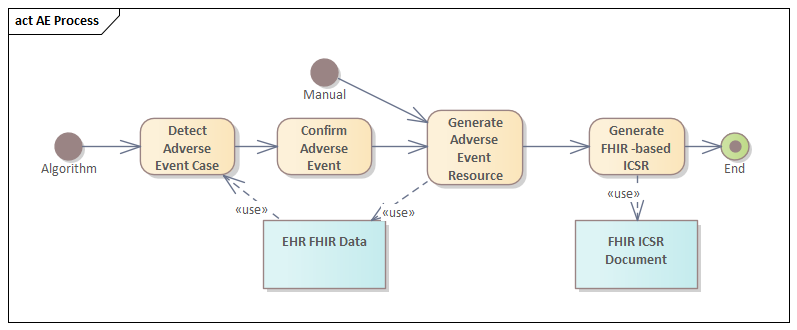This page is part of the Profiles for ICSR Transfusion and Vaccination Adverse Event Detection and Reporting (v1.0.1: STU 1 Update) based on FHIR R4. This is the current published version in its permanent home (it will always be available at this URL). For a full list of available versions, see the Directory of published versions 
| Official URL: http://hl7.org/fhir/us/icsr-ae-reporting/ImplementationGuide/hl7.fhir.us.icsr-ae-reporting | Version: 1.0.1 | |||
| Draft as of 2023-08-29 | Computable Name: TransfusionVaccinationAdverseEventDetectionReporting | |||
This FHIR Implementation Guide details a process where adverse event (AE) reports are generated from EHR data. The report data elements are based from the Food and Drug Administration’s Individual Case Safety Reports specifications. These specifications can be found at FDA’s website. In this guide, there are two main components to the generation process: detection and reporting. To support AE detection, this IG includes a set of Clinical Quality Language (CQL) algorithms which can be run on FHIR data. To support AE reporting, this IG includes a set of profiles that enables the creation of a FHIR case report document along with mappings to the ICH ICSR specifications. This work was developed as part of the FDA’s Center for Biologic Evaluation and Research (CBER) Biologics Effectiveness and Safety (BEST) initiative. This IG currently focuses on post-vaccination and post-tranfusion AE reporting.
Adverse events due to biological products are underreported to regulatory authorities and the data reported may not always contain adequate information for decision-making. Use of EHR FHIR data could improve reporting of adverse events and minimize the burden of identification on practitioners.
This IG depends on:
We consider the AE Detection and Submission workflow to be a combination of MedMorph’s Report Creation and Data Submission workflows.
NOTE: The diagram below is a UML activity diagram. The «use» stereotypes indicate data that is used by the associated activity. If the arrow is pointing to the activity, then the activity is reading that data. If the arrow is pointing away from the activity, then the activity is generating that data.

The activities from Detect Adverse Event Case to Generate Adverse Event Resource are part of the Report Creation workflow while the remaining activities are part of the Data Submission workflow.
A system can detect AE cases automatically using the FHIR-based CQL algorithms referenced in this IG.
Once an Adverse Event has been detected, a practitioner can review the relevant data and confirm that it is an actual Adverse Event that should be reported.
Once an Adverse Event has been confirmed or if a practitioner manually determines there is an Adverse Event to report, a system can generate an instance of the FHIR AdverseEvent resource.
A system can generate a FHIR-based Adverse Event document using the profiles referenced in this IG.
As with implementations of FHIR and FHIR Implementation Guides, implementers should consult the FHIR Implementer’s Safety Check List in the core FHIR specification.
The development of this Implementation Guide was funded by FDA CBER BEST initiative.
For more information about this guide or if you have any questions or comments about it, either use the “Propose a change” link found at the bottom of every page or visit the BEST Initiative website.